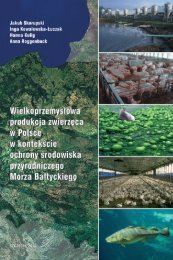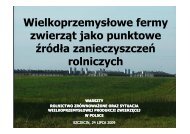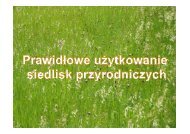best available technologies for manure treatment - Baltic Green Belt
best available technologies for manure treatment - Baltic Green Belt
best available technologies for manure treatment - Baltic Green Belt
You also want an ePaper? Increase the reach of your titles
YUMPU automatically turns print PDFs into web optimized ePapers that Google loves.
Best Available Technologies <strong>for</strong> <strong>manure</strong> <strong>treatment</strong> baltic sea 2020<br />
1: INTRODUCTION AND BACKGROUND DESCRIPTION<br />
plant nutrients in slurry from production pigs is a bit<br />
better in balance with the needs of the crops than the<br />
case is <strong>for</strong> slurry from sow production. However, in<br />
all cases, whether a limit of 170 or 140 kg N per ha<br />
is used as a limit <strong>for</strong> fertilising with livestock <strong>manure</strong>,<br />
the spreading of P on the fields is above the P norms<br />
<strong>for</strong> a typical crop rotation on a pig farm.<br />
It should be noted in connection to the Table 1<br />
and Table 4 that winter wheat is the most commonly<br />
grown crop on pig production farms in Denmark<br />
(Weznæs et al., 2009) and probably in the entire<br />
<strong>Baltic</strong> Sea Region (BSR). Fertiliser norms <strong>for</strong> grass is<br />
also shown in Table 1, although this is not a common<br />
crop on pig production farms – however, grass<br />
is basically a protein crop, there<strong>for</strong>e requiring a high<br />
N fertilisation, and being the reason <strong>for</strong> derogations<br />
admitted cattle farms in Denmark and Holland to<br />
the general rule of maximally 170 kg N per ha from<br />
livestock <strong>manure</strong>.<br />
According HELCOM Convention, Annex III<br />
section 2.1, “The maximum number of animals<br />
should be determined with consideration taken to<br />
the need to balance between the amount of P and<br />
N in <strong>manure</strong> and the crops’ requirements <strong>for</strong> plant<br />
nutrients.” It decides <strong>for</strong> Contracting Parties that<br />
“The amount of livestock <strong>manure</strong> applied to the land<br />
each year including by the animals themselves should<br />
not exceed the amount of <strong>manure</strong> containing 170 kg/<br />
ha nitrogen and 25 kg/ha phosphorus with a view to<br />
avoiding nutrient surplus, taking soil characteristics,<br />
agricultural practices and crop types into account.”<br />
Four of the eight target countries have consequently<br />
introduced official P norms <strong>for</strong> fertilising:<br />
In Sweden and in Lithuania the norms have been set<br />
as a general limit without respect to the actual crop<br />
grown. The limit in Sweden is 22 kg P per ha, and<br />
similarly 40 kg P2O5 in Lithuania. German farmers<br />
are restricted by a P balance of 20 kg P2O5 per ha<br />
(Foged, 2008). Denmark has introduced a maximal<br />
allowed spreading of 140 kg N in livestock <strong>manure</strong><br />
per ha, but as seen from Table 4, this is not a sufficiently<br />
low rate to avoid over-fertilisation with P;<br />
Danish installations <strong>for</strong> the intensive rearing of pigs<br />
typically maximise their production up to the 140 kg<br />
N per ha limit. In Finland the P limits are based on<br />
crops grown and the soil P content. If only <strong>manure</strong> is<br />
used as P-fertilizer about 18 kg of <strong>manure</strong> total P can<br />
be spread <strong>for</strong> grain crops (if the soil P content is not<br />
very high).<br />
Annex L includes statistics about the pig production<br />
in Denmark, Poland and Sweden, as well as<br />
maps with the geographical placement of pig farms<br />
in Denmark and the installations <strong>for</strong> the intensive<br />
rearing of pigs in Poland.<br />
Animal type<br />
Number of animals that can be<br />
contained within 1 ha of winter<br />
wheat according norms in Table 1<br />
Kg P spread per ha per year, if the<br />
limit <strong>for</strong> N fertilisation in livestock<br />
<strong>manure</strong> is fully utilised<br />
N<br />
P<br />
170 kg N per as<br />
limit<br />
140 kg N per ha<br />
as limit<br />
Total <strong>for</strong> a sow in one year<br />
with production of 26<br />
piglets of 32 kg<br />
5,1 2,2 47,43 38,75<br />
10 production pigs<br />
produced, 32 to 107 kg,<br />
fully slotted floors<br />
64,4 37,7 34,12 28,11<br />
Table 4: Number of sows or production pigs that produces N and P equivalent to the consumption of one ha<br />
winter wheat – by comparison of Table 1 and Table 3, and amount of P spread if the allowed spreading of N<br />
is the limiting factor.<br />
15








